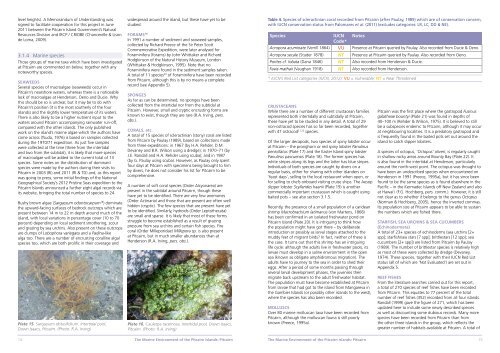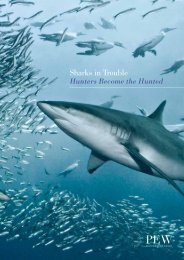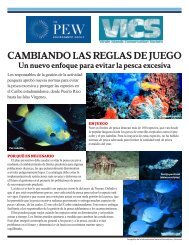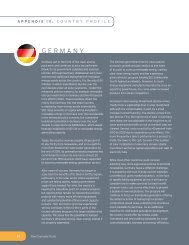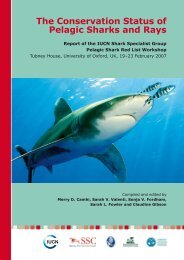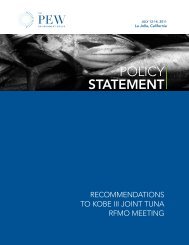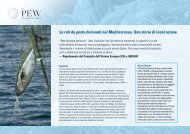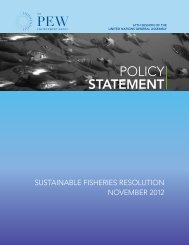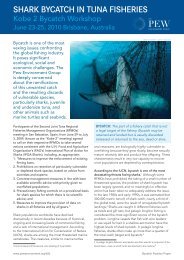The Marine Environment of the Pitcairn Islands - Pew Environment ...
The Marine Environment of the Pitcairn Islands - Pew Environment ...
The Marine Environment of the Pitcairn Islands - Pew Environment ...
You also want an ePaper? Increase the reach of your titles
YUMPU automatically turns print PDFs into web optimized ePapers that Google loves.
level heights). A Memorandum <strong>of</strong> Understanding was<br />
signed to facilitate cooperation for this project in June<br />
2011 between <strong>the</strong> <strong>Pitcairn</strong> Island Government’s Natural<br />
Resources Division and IRCP / CRIOBE (Chancerelle & Lison<br />
de Loma, 2009).<br />
3.1.4 <strong>Marine</strong> species<br />
Those groups <strong>of</strong> marine taxa which have been investigated<br />
at <strong>Pitcairn</strong> are commented on below, toge<strong>the</strong>r with any<br />
noteworthy species.<br />
SEAwEEDS<br />
Several species <strong>of</strong> macroalgae (seaweeds) occur in<br />
<strong>Pitcairn</strong>’s nearshore waters, whereas <strong>the</strong>re is a noticeable<br />
lack <strong>of</strong> macroalgae at Henderson, Oeno and Ducie. Why<br />
this should be so is unclear, but it may be to do with<br />
<strong>Pitcairn</strong>’s position (it is <strong>the</strong> most sou<strong>the</strong>rly <strong>of</strong> <strong>the</strong> four<br />
islands) and <strong>the</strong> slightly lower temperature <strong>of</strong> its waters.<br />
<strong>The</strong>re is also likely to be a higher nutrient input to <strong>the</strong><br />
waters around <strong>Pitcairn</strong> accompanying rainwater run-<strong>of</strong>f,<br />
compared with <strong>the</strong> o<strong>the</strong>r islands. <strong>The</strong> only published<br />
work on <strong>the</strong> island’s marine algae which <strong>the</strong> authors have<br />
come across (Tsuda, 1976) is based on samples collected<br />
during <strong>the</strong> 1970/71 expedition. As just five samples<br />
were collected at <strong>the</strong> time (three from <strong>the</strong> intertidal<br />
and two from <strong>the</strong> subtidal), it is likely that more species<br />
<strong>of</strong> macroalgae will be added to <strong>the</strong> current total <strong>of</strong> 13<br />
species. Some notes on <strong>the</strong> distribution <strong>of</strong> dominant<br />
species were made by <strong>the</strong> authors during <strong>the</strong>ir visits to<br />
<strong>Pitcairn</strong> in 2003 (RI) and 2011 (RI & TD) and, as this report<br />
was going to press, some initial findings <strong>of</strong> <strong>the</strong> National<br />
Geographical Society’s 2012 Pristine Seas expedition to <strong>the</strong><br />
<strong>Pitcairn</strong> <strong>Islands</strong> announced a fur<strong>the</strong>r eight algal records via<br />
its website, bringing <strong>the</strong> total number <strong>of</strong> species to 24.<br />
Bushy brown algae (Sargassum odontocarpum 18 ) dominate<br />
<strong>the</strong> upward-facing surfaces <strong>of</strong> bedrock outcrops which are<br />
present between 14 m to 22 m depth around much <strong>of</strong> <strong>the</strong><br />
island, with local variations in percentage cover (10 to 70<br />
percent) depending on local sediment smo<strong>the</strong>ring, scour<br />
and grazing by sea urchins. Also present on <strong>the</strong>se outcrops<br />
are clumps <strong>of</strong> Lobophora variegata and a Padina-like<br />
alga too. <strong>The</strong>re are a number <strong>of</strong> encrusting coralline algal<br />
species too, which are both prolific in <strong>the</strong>ir coverage and<br />
Plate 15. Sargassum obtusifolium. Intertidal pool,<br />
Down Isaacs, <strong>Pitcairn</strong>. (Photo: R.A. Irving)<br />
widespread around <strong>the</strong> island, but <strong>the</strong>se have yet to be<br />
studied.<br />
FORAMS 19<br />
In 1991 a number <strong>of</strong> sediment and seaweed samples,<br />
collected by Richard Preece <strong>of</strong> <strong>the</strong> Sir Peter Scott<br />
Commemorative Expedition, were later analysed for<br />
Foraminifera (forams) by John Whittaker and Richard<br />
Hodgkinson <strong>of</strong> <strong>the</strong> Natural History Museum, London<br />
(Whittaker & Hodgkinson, 1995). Note that no<br />
Foraminifera were found in <strong>the</strong> sediment samples taken.<br />
A total <strong>of</strong> 11 species 20 <strong>of</strong> Foraminifera have been recorded<br />
from <strong>Pitcairn</strong>, although this is by no means a complete<br />
record (see Appendix 5).<br />
SPONGES<br />
As far as can be determined, no sponges have been<br />
collected from <strong>the</strong> intertidal nor from <strong>the</strong> subtidal at<br />
<strong>Pitcairn</strong>. However, small and cryptic encrusting forms are<br />
known to exist, though <strong>the</strong>y are rare (R.A. Irving, pers.<br />
obs.).<br />
CORALS, etc.<br />
A total <strong>of</strong> 15 species <strong>of</strong> scleractinian (stony) coral are listed<br />
from <strong>Pitcairn</strong> by Paulay (1989), based on collections made<br />
from three expeditions: in 1967 (by H.A. Rehder, D.M.<br />
Devaney and B.R. Wilson using a dredge); in 1970–71 (by<br />
J.E. Randall and H.A. Rehder using scuba); and in 1987<br />
(by G. Paulay using scuba). However, as Paulay only spent<br />
four days at <strong>Pitcairn</strong> with specimens being brought to him<br />
by divers, he does not consider his list for <strong>Pitcairn</strong> to be<br />
comprehensive.<br />
A number <strong>of</strong> s<strong>of</strong>t coral species (Order Alcyonarea) are<br />
present in <strong>the</strong> subtidal around <strong>Pitcairn</strong>, though <strong>the</strong>se<br />
have yet to be identified. <strong>The</strong>re are very few anemones<br />
(Order Actinaria) and those that are present are <strong>of</strong>ten well<br />
hidden (cryptic). <strong>The</strong> few species that are present have yet<br />
to be identified. Similarly, hydroids (Order Lepto<strong>the</strong>cata)<br />
are small and sparse. It is likely that most <strong>of</strong> <strong>the</strong>se forms<br />
struggle to become established as a result <strong>of</strong> grazing<br />
pressure from sea urchins and certain fish species. Fire<br />
coral (Order Milleporidae) Millepora sp. is also present<br />
at <strong>Pitcairn</strong>, but in much smaller abundances than at<br />
Henderson (R.A. Irving, pers. obs.).<br />
Plate 16. Caulerpa racemosa. Intertidal pool, Down Isaacs,<br />
<strong>Pitcairn</strong>. (Photo: R.A. Irving)<br />
CRUSTACEANS<br />
While <strong>the</strong>re are a number <strong>of</strong> different crustacean families<br />
represented both intertidally and subtidally at <strong>Pitcairn</strong>,<br />
<strong>the</strong>se have yet to be studied in any detail. A total <strong>of</strong> 29<br />
non-ostracod species has so far been recorded, toge<strong>the</strong>r<br />
with 47 ostracod 21 22 species.<br />
Of <strong>the</strong> larger decapods, two species <strong>of</strong> spiny lobster occur<br />
at <strong>Pitcairn</strong> – <strong>the</strong> pronghorn or red spiny lobster Panulirus<br />
penicillatus (Plate 17) and <strong>the</strong> Easter Island spiny lobster<br />
Panulirus pascuensis (Plate 18). <strong>The</strong> former species has<br />
white stripes along its legs and <strong>the</strong> latter has blue stripes.<br />
Individuals <strong>of</strong> both species are caught by divers on a<br />
regular basis, ei<strong>the</strong>r for sharing with o<strong>the</strong>r islanders on<br />
‘feast days’, selling to <strong>the</strong> local restaurant when open, or<br />
for selling to chefs onboard visiting cruise ships. <strong>The</strong> Aesop<br />
slipper lobster Scyllarides haanii (Plate 19) is ano<strong>the</strong>r<br />
commercially important crustacean which is caught using<br />
baited pots – see also section 3.1.5.<br />
Recently, <strong>the</strong> presence <strong>of</strong> a small population <strong>of</strong> a caridean<br />
shrimp Macrobrachium latimanus (von Martens, 1868)<br />
has been confirmed in an isolated freshwater pond on<br />
<strong>Pitcairn</strong> Island (Plate 20). It is intriguing to think how<br />
<strong>the</strong> population might have got <strong>the</strong>re – by deliberate<br />
introduction or possibly as larval stages attached to <strong>the</strong><br />
muddy feet <strong>of</strong> migrant birds? In fact, nei<strong>the</strong>r <strong>of</strong> <strong>the</strong>se is<br />
<strong>the</strong> case. It turns out that this shrimp has an intriguing<br />
life cycle: although <strong>the</strong> adults live in freshwater pools, its<br />
larvae must develop in a saline environment in <strong>the</strong> open<br />
sea (known as obligate amphidromous migration). <strong>The</strong><br />
adults have to journey to <strong>the</strong> sea in order to shed <strong>the</strong>ir<br />
eggs. After a period <strong>of</strong> some months passing through<br />
several larval development phases, <strong>the</strong> juveniles <strong>the</strong>n<br />
migrate back upstream to <strong>the</strong> adult freshwater habitat.<br />
<strong>The</strong> population must have become established at <strong>Pitcairn</strong><br />
from larvae that had got to <strong>the</strong> island from Mangareva in<br />
<strong>the</strong> Gambier <strong>Islands</strong> (or possibly o<strong>the</strong>r islands to <strong>the</strong> west),<br />
where <strong>the</strong> species has also been recorded.<br />
MOLLUSCS<br />
Over 80 marine molluscan taxa have been recorded from<br />
<strong>Pitcairn</strong>, although <strong>the</strong> molluscan fauna is still poorly<br />
known (Preece, 1995a).<br />
14 <strong>The</strong> <strong>Marine</strong> <strong>Environment</strong> <strong>of</strong> <strong>the</strong> <strong>Pitcairn</strong> <strong>Islands</strong>: <strong>Pitcairn</strong><br />
<strong>The</strong> <strong>Marine</strong> <strong>Environment</strong> <strong>of</strong> <strong>the</strong> <strong>Pitcairn</strong> <strong>Islands</strong>: <strong>Pitcairn</strong><br />
Table 4. Species <strong>of</strong> scleractinian coral recorded from <strong>Pitcairn</strong> (after Paulay, 1989) which are <strong>of</strong> conservation concern,<br />
with IUCN conservation status from Palomares et al. (2011) (excludes categories: LR, LC, DD & NE).<br />
Species IUCN<br />
Code*<br />
Notes<br />
Acropora acuminate (Verrill 1864) VU Presence at <strong>Pitcairn</strong> queried by Paulay. Also recorded from Ducie & Oeno.<br />
Acropora secale (Studer 1878) NT Presence at <strong>Pitcairn</strong> queried by Paulay. Also recorded from Oeno.<br />
Porites cf. lobata (Dana 1846) NT Also recorded from Henderson & Ducie.<br />
Favia mathaii (Vaughan 1918) NT Also recorded from Henderson.<br />
* IUCN’s Red List categories (IUCN, 2012): VU = Vulnerable; NT = Near Threatened<br />
<strong>Pitcairn</strong> was <strong>the</strong> first place where <strong>the</strong> gastropod Fusinus<br />
gala<strong>the</strong>ae bountyi (Plate 21) was found in depths <strong>of</strong><br />
40–100 m (Rehder & Wilson, 1975). It is believed to still<br />
be a subspecies endemic to <strong>Pitcairn</strong>, although it may occur<br />
at neighbouring localities. It is a predatory gastropod and<br />
is frequently found in <strong>the</strong> baited pots set out around <strong>the</strong><br />
island to catch slipper lobsters.<br />
A species <strong>of</strong> octopus, ‘Octopus’ oliveri, is regularly caught<br />
in shallow rocky areas around Bounty Bay (Plate 22). It<br />
is also found in <strong>the</strong> intertidal at Henderson, particularly<br />
around <strong>the</strong> north-west point. <strong>The</strong> octopus was thought to<br />
have been an undescribed species when encountered on<br />
Henderson in 1991 (Preece, 1995a), but it has since been<br />
found to be <strong>the</strong> same species as is found elsewhere in <strong>the</strong><br />
Pacific – in <strong>the</strong> Kermadec <strong>Islands</strong> <strong>of</strong>f New Zealand and also<br />
at Hawai’i (F.G. Hochberg, pers. comm.). However, it is still<br />
not clear as to whe<strong>the</strong>r it belongs to <strong>the</strong> genus Octopus<br />
(Norman & Hochberg, 2005), hence <strong>the</strong> inverted commas.<br />
Its population size at <strong>Pitcairn</strong> appears to be able to sustain<br />
<strong>the</strong> numbers which are fished <strong>the</strong>re.<br />
STARFISH, SEA URCHINS & SEA CUCUMBERS<br />
(Echinodermata)<br />
A total <strong>of</strong> 23+ species <strong>of</strong> echinoderms (sea urchins [2+<br />
spp]; starfish/sea stars [7 spp]; brittlestars [12 spp]; sea<br />
cucumbers [2+ spp]) are listed from <strong>Pitcairn</strong> by Paulay<br />
(1989). <strong>The</strong> number <strong>of</strong> brittlestar species is relatively high<br />
as most <strong>of</strong> <strong>the</strong>se were collected by dredge (Devaney,<br />
1974). <strong>The</strong>se species, toge<strong>the</strong>r with <strong>the</strong>ir IUCN Red List<br />
status (all <strong>of</strong> which are ‘Not Evaluated’) are set out in<br />
Appendix 5.<br />
REEF FISHES<br />
From <strong>the</strong> literature searches carried out for this report,<br />
a total <strong>of</strong> 270 species <strong>of</strong> reef fishes have been recorded<br />
from <strong>Pitcairn</strong>. This equates to 77 percent <strong>of</strong> <strong>the</strong> total<br />
number <strong>of</strong> reef fishes (352) recorded from all four islands.<br />
Randall (1999) gave <strong>the</strong> figure <strong>of</strong> 271, which has been<br />
updated here to include some newly described species<br />
as well as discounting some dubious records. Many more<br />
species have been recorded from <strong>Pitcairn</strong> than from<br />
<strong>the</strong> o<strong>the</strong>r three islands in <strong>the</strong> group, which reflects <strong>the</strong><br />
greater number <strong>of</strong> habitats available at <strong>Pitcairn</strong>. A total <strong>of</strong><br />
15


